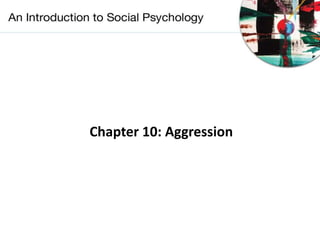
Chapter 10 Aggression
- 2. What is Aggression? Aggression, thus, can be described as a behaviour that is intentional in nature and is mainly aimed at inflicting pain— psychological or physical—to another person or even object. Weiss (1969) described aggression as 'a behaviour directed against an object, and its primary intent or purpose is to injure'. Sears, Peplau and Taylor (1991, p. 335) defined aggression as 'any action that is intended to hurt others'. Baron (1977, p. 7) described aggression as 'any form of behaviour directed toward the goal of harming or injuring another living being who is motivated to avoid such treatment'. Two main key points can be highlighted in this definition are that it is an infliction of harm on another person or being and the behaviour is deliberate with intention to harm. According to Bushman and Anderson (2001, p. 274), 'aggression is any behaviour directed toward another individual that is carried out with the intent to cause harm. In addition, the perpetrator must believe that the behaviour will harm the target and that the target is motivated to avoid the behaviour'. Aggression can be perceived as universal, and aggressive impulses and tendencies also seem natural (Baumeister & Bushman, 2008).
- 3. 1.Hostile aggression: This can be described as behaviour that is directed towards harming another individuals. This type of aggression mainly stems from anger and is also termed as emotional aggression or reactive aggression. For example, when in anger, a person slaps another person; this can be termed as hostile aggression. Hostile aggression is a reaction or response that is typical in nature. 2.Instrumental aggression: This can be described as a behaviour that is again directed to harm another individual. but the behaviour is an instrument to achieve a non-aggressive goal. This is also termed as a proactive aggression and is also intentional and future-oriented (Barrett, 2017). For example, in a game of football, aggression that is directed to make a goal or win the game. 3.Direct and indirect aggression: In direct aggression, the target towards whom the aggression is directed is physically present, and in indirect aggression, the target towards whom the aggression is directed is not physically present. 4.Violence: Yet another form of aggression is violence. Though most often it is used interchangeably with the term aggression, violence can be terms as an aggression that is extreme and is also directed to seriously harm others. For example, stabbing a person with a knife. Forms of Aggression
- 4. • The term is defined as 'behaviour that either damages interpersonal relationships or is culturally undesirable' (Baumeister & Bushman, 2008, p. 264). • Antisocial behaviour can also be explained in terms of the following forms of antisocial behaviour: - Cheating: Cheating could occur in exams, during sports performance and so on. And though perceived as antisocial behaviour, it is still prevalent in our society. Studies have indicated that low academic ability, low self control and persons who are pessimistic are more likely to indulge in cheating (Baumeister and - Stealing: Stealing or theft as an antisocial behaviour can be attributed to de-individuation that may take place when one is in a group. People are more prone to indulging in an antisocial behaviour when they are in groups. - Littering: Littering is yet another antisocial behaviour that we commonly observe in India. Many of us have come across situations where the window of the vehicle in front of you is slide down and a chips packet or a cold drink bottle is thrown out of it. Antisocial Behaviour
- 5. Biological theories (instinct theory, psychodynamic theory) Frustration-Aggression hypothesis Cognitive neoassociationism Extinction-transfer model Learning theories (operant conditioning theory, social learning theory) General aggression model Theories of Aggression
- 6. Person-centered determinants (gender differences, personality, alcohol consumption) Situation-centered determinants (physical environment, frustration, social disadvantage and social rejection, provocation Cultural influences Median influence Determinants of Aggression
- 7. Punishment Punishment is one of the techniques that has been frequently used to deal with aggression and even violence. It is assumed that punishment will lead to suppression of aggressive behaviour. There are also laws in place for violence and crimes such as murder, rape and so on. If punishment is appropriately used, it can lead to deterrent of aggression; however, a number of conditions needs to be kept in mind while doing so: 1. The punishments should immediately follow the aggressive behaviour. 2. The magnitude of punishment should be adequate so that it is seen as aversive by the recipient. 3. The likelihood that it is a likely outcome to an aggressive behaviour should be high. • Catharsis Certain activities can help individuals vent out their aggressive impulses and, thus, help reduce aggressive behaviour. The catharsis hypothesis can be discussed here that states that indulging in activities that help individuals express or vent out their anger and hostility is a way that is safe will lead to decreased aggressive behaviour (Baron & Byrne, 1995). Such activities not only help decrease anger but also help the individual to diminish emotional tension, though studies have shown mixed results with regard to the effectiveness of catharsis in reducing aggressive behaviour (Baron & Byrne, 1995). Prevention and Control of Aggression
- 8. • Cognitive interventions • Exposure to non-aggressive models • Social skills training • Incompatible responses Other Techniques